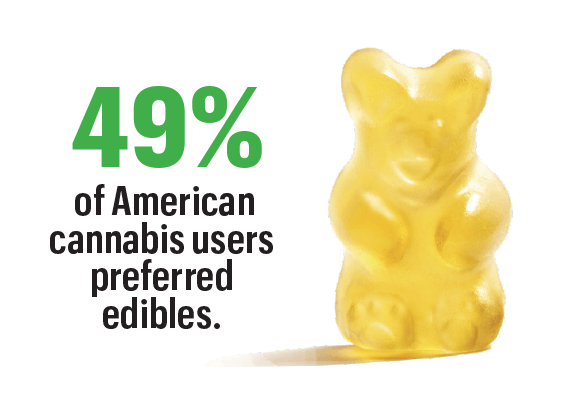In the News Special Report
WHAT WE KNOW ABOUT MEDICAL MARIJUANA
Medical cannabis is legal in 38 states, and gummy consumption is exploding. But is it safe and effective? Sometimes yes, sometimes no

Carminetta Verner didn’t smoke pot in the 1960s. But when medical marijuana was legalized in Maryland in 2014, the 89-year-old retired accountant learned everything she could about cannabis.
Today, Verner makes her own cannabis-infused products to ease pain and insomnia caused by a rare connective-tissue disease. Among her favorites: edibles, including gummies. They’re a hot topic at the cannabis club Verner started at the Leisure World retirement community in Silver Spring, Maryland. “Gummies are very popular because of ease of use,” she says.
“But,” emphasizes Verner, the grandmother of four, “they can be dangerous for older adults.”
Cannabis sales are soaring, topping $27 billion in 2022. Medical marijuana is now allowed in 38 states and three U.S. territories, while adult recreational use is legal in 24 states, up from 33 states and 11, respectively, in 2019. And as America’s preferred form of medical marijuana intake shifts from pot-smoking to munching the colorful little gummies, older adults lead the way: 16 million Americans 50-plus tried cannabis in 2022, up from 12.8 million in 2021.
Amid this interest from older adults, it’s no wonder gummies reached a milestone last year, when the percentage of people buying chewables surpassed the number purchasing smokable marijuana—49 to 47 percent. But how safe are edibles? The jury—in this case, physicians and marijuana researchers—remains undecided.
UPSIDES, DOWNSIDES
Twenty-eight years after California became the first state in America to legalize medical marijuana, and five years after the Bulletin’s comprehensive look at cannabis [“Special Report: Marijuana and Your Health,” September 2019], there are still plenty of unknowns about the health benefits and risks of all forms of medical cannabis.
The evidence indicates cannabis helps with chronic pain and some sleep and anxiety problems, says Samoon Ahmad, M.D., a professor of psychiatry at NYU Grossman School of Medicine and coauthor of a medical marijuana handbook. “They appear to be most effective in treating neuropathic [nerve] and other types of chronic pain more prevalent in older patients,” Ahmad says. “Patients often say that it’s like the volume has been turned down so that the pain is less perceptible.”
However, cannabis doesn’t help much with short-term pain, such as a headache, sprained ankle or recovery after surgery, he adds. And it is not a proven treatment for glaucoma or high blood pressure. In a study published this year, in fact, regular use was linked with a 25 percent higher risk of heart attack and a 42 percent higher risk of stroke.
GUMMY QUIRKS
More Americans, young and old, mainly prefer gummies and other edibles for their ease of use and averred health benefits. “Infused edibles, including gummies, are generally more discreet to consume,” notes Brian Sterling, head of the Canadian research company SCS Consulting. “And consumers generally are more leery of smoking any product, cannabis included,” as users shy away from inhaled products that could affect the lungs.
But edibles pose a unique risk: It’s easy to overdo them. “They look like candy,” says marijuana researcher Kevin F. Boehnke at the University of Michigan. “If somebody is like, ‘Oh, this tastes good, I’m going to eat a couple,’ you could have too much. It can take two to three hours to feel the full effects.”

That can have unintended consequences. A 2023 study found that emergency room visits for cannabis-related problems increased 1,808 percent among people 65 and older from 2005 to 2019 in California.
As has long been the case, research on cannabis, though ramping up, is thin, but studies indicate that sudden, short-term mental health problems such as severe anxiety and cardiovascular symptoms were more common among those who used edibles than smokers and vapers.
All that explains why at the Leisure World Cannabis 101 Club, Carminetta Verner is very cautious about spreading the gummy gospel. She recommends that new users keep a detailed journal of what they take, as well as the results, to see whether a gummy, or anything else, helps or has side effects. “Each person’s metabolism is different, and you have to learn how your body reacts,” she says. “The cannabis mantra is ‘start low and go slow.’ ”
Sari Harrar is a contributing editor to AARP The Magazine and also writes frequently for the Bulletin on health, fraud and consumer affairs.
YASU & JUNKO/Trunk Archive (2)